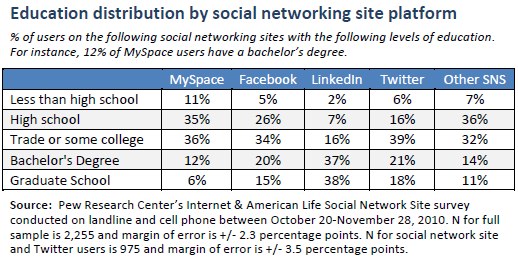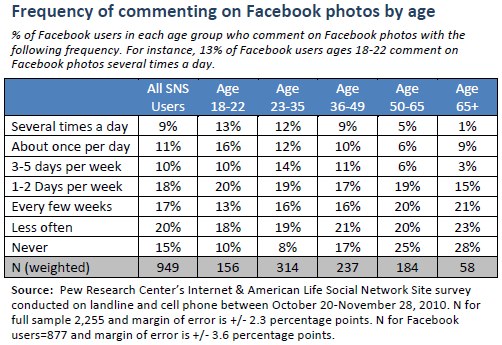Most online Americans use at least one social networking site, and the demographics of the SNS population are shifting to older users.
Of the things Americans do online, few activities have received as much recent attention as the use of social networking sites (SNS). These sites, which include Facebook, MySpace, LinkedIn, and Twitter are defined by their unique focus on allowing people to “friend” others and share content with other users. By some accounts, Americans spend more time on SNS than doing any other single online activity [2].
In this Pew Internet sample, 79% of American adults said they used the internet and nearly half of adults (47%), or 59% of internet users, say they use at least one of SNS. This is close to double the 26% of adults (34% of internet users) who used a SNS in 2008 [1].
Internet users of all ages are more likely to use a SNS today than they were in 2008. However, the increase in SNS use has been most pronounced among those who are over the age of 35. In 2008 only 18% of internet users 36 and older used a SNS, by 2010 48% of internet users over the age of 35 were using a SNS. This is about twice the growth experienced by internet users 18-35; 63% of whom used a SNS in 2008 compared with 80% in 2010. Among other things, this means the average age of adult-SNS users has shifted from 33 in 2008 to 38 in 2010. Over half of all adult SNS users are now over the age of 35.

As with the use of most social media, SNS users are disproportionately female (56%). Women also comprise the majority of email users (52% women), users of instant message (55%), bloggers (54%), and those who use a photo sharing service (58%).

Who uses what social networking site platform
There is a great deal of variation in the age, sex, race, and educational attainment among those who use different SNS platforms.
- Nearly twice as many men (63%) as women (37%) use LinkedIn. All other SNS platforms have significantly more female users than male users.
- The average adult MySpace user is younger (32), and the average adult LinkedIn user older (40), than the average Facebook user (38), Twitter user (33), and users of other SNS users (35).
- MySpace and Twitter users are the most racially diverse mainstream social network platforms. However, a large proportion of users of “other” social network services are racial minorities.
- MySpace users tend to have fewer years of formal education than users of other social network services, whereas most LinkedIn users have at least one university degree.




The rise and fall of different social networking site platforms
Twitter is the SNS that has experienced the most recent growth in new members. On the other hand, a very small number of people have joined MySpace in the past year. Fewer than 3% of all MySpace users joined within the past 6-months, 10% joined within the past year. Over 75% of MySpace users joining the site two or more years ago. In comparison, nearly 60% of Twitter users, 39% of Facebook users, and 36% of LinkedIn users joined within the past year.

Facebook is the nearly universal social networking site and it has the highest share of users’ daily visits, while MySpace and LinkedIn are occasional destinations.
Facebook is, by far, the most popular SNS. Of those who use a SNS, almost all use Facebook (92%). Facebook is followed in popularity by MySpace (29%), LinkedIn (18%), Twitter (13%), and other social network services (10%).
There is notable variation in the frequency of use of SNS. Facebook and Twitter are used much more frequently by their users than LinkedIn and MySpace. Some 52% of Facebook users and 33% of Twitter users engage with the platform daily, while only 7% of MySpace users and 6% of LinkedIn users do the same. By comparison, 62% of MySpace users, 40% of Twitter users, and 44% of LinkedIn users engage with their SNS less than once per month. Only 6% of Facebook users use this platform less than once per month.

What do people do on Facebook?
Social network services (SNS) have a number of common features. These include the ability of users to create a list of “friends,” update their “status,” to comment on other users’ statuses and content, to indicate that they like another user’s content, and to send private messages. We asked survey participants to report on the frequency at which they perform these various activities on Facebook.
On an average day:
- 15% of Facebook users update their own status.
- 22% comment on another’s post or status.
- 20% comment on another user’s photos.
- 26% “Like” another user’s content.
- 10% send another user a private message
Most people update their status less than once per week.
The act of contributing a status update is an infrequent activity for most users. A majority of Facebook users (56%) update their status less than once per week. Only 15% of Facebook users update their status at least once per day. Nearly one in six (16%) have never updated their status.
Women and the young drive Facebook usage.
Some 18% of women update their Facebook status at least once per day. Only 11% of men do the same. At the same time, Facebook users over the age of 35 are the least likely to have ever updated their Facebook profile or to update their status more than 1-2 days per week.


Facebook users are more likely to comment on another user’s status than to update their own status.
Despite the relative infrequency at which most users update their own status, most Facebook users comment on other users’ statuses at least 1-2 days per week (53%). More than one in five Facebook users (22%) comment on another user’s post at least once per day. Younger Facebook users are most likely to comment at least once per day; 23% of Facebook users under the age of 36 comment at least once per day. However, while comment frequency declines with age, one in five (18%) Facebook users under the age of 50 still comments at least once per day. Women are much more likely to leave comments on daily basis; 25% of female Facebook users comment on a post at least daily, the same is true of only 17% of male users.


Half of Facebook users comment on photos at least 1-2 times each week.
Nearly as popular as commenting on another users’ status is the practice of commenting on another users’ photos. Half of all Facebook users (49%) comment on a photo that was contributed by another user at least 1-2 times per week. Some 20% of Facebook users comment on another user’s photo at least once per day. Frequency of commenting on photos declines with age. However, the frequency of comments on photos is still very high amongst older age groups. Some 10% of Facebook users over the age of 50 comment on a photo each day, while 33% of Facebook users over the age of 50 comment on a photo at least 1-2 times per week. Women are much more likely to comment on photos than are men. 19% of men have never commented on a photo, while only 13% of women have never commented on a photo. Only 13% of men comment on photos on a daily basis, whereas 25% of female Facebook users comment on a photo at least once per day.


Facebook users like to “like” each other.
In addition to the option of commenting on status updates and content contributed by other users, Facebook users also have the option of clicking on a button to indicate that they “Like” another user’s content or status. This activity was more popular than any other Facebook activity we measured.
- 26% of all Facebook users indicate that they “Like” content contributed by another Facebook user at least once per day.
- 44% of Facebook users who are 18-22 years old “Like” their friends’ content on a daily basis. While declining with age, a full 12% of Facebook users over the age of 50 “Like” content at least once per day.
- Men are much more likely to have never “Liked” any of their friends’ content– 28% of men have never “Liked” something contributed on Facebook compared with only 18% of women.


Private messages are infrequently used.
In addition to status updates, commenting, and liking content, Facebook users can also send each other private messages. The majority of Facebook users have sent private messages (82%), but only 37% send at least one message per week. Younger users are modestly more likely to send private messages; 45% of 18-22 year olds send at least one private message per week, compared with 32% of those aged 36-49 and 27% over the age of 50. There is little difference between men and women in their use of Facebook for private messages.




